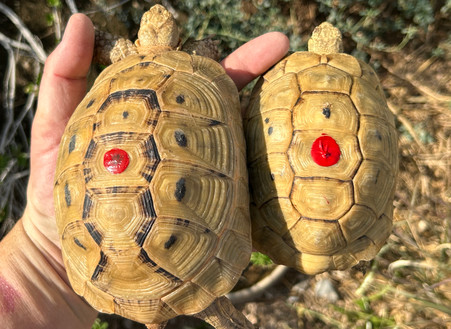- Home
- Tortoises For Sale
- Greek Tortoises For Sale
- Golden Greek Tortoise Pair
- Home
- Tortoises For Sale
- Pet Tortoises For Sale - 4" Size or Larger
- Golden Greek Tortoise Pair
Golden Greek Tortoise Pair
Product Reviews
Description
*This is a PAIR of tortoises, so in buying the "pair," you're getting a male and female tortoise.
Common Name: Greek Tortoise
Scientific Name: Testudo Graeca Terrestris
Current Size: 5" male, 6" female +/-
Average Adult Size: 6-9" (females larger)
Area of Origin: Middle East / Lebanon
Description: Bright yellowish tan color with none or minimal black patches in the center of most scutes of the shell. They have little or no black banding around the scutes of their shell and are 90% or more yellow/gold in color. Head, arms and skin color is yellow. They are a high domed tortoise, and like most Greek tortoises, they maintain a "glossy" looking shell through life. As babies, these Greek tortoises look very similar to baby Hermanns tortoises with a much lighter yellow overall color. This subspecies of Greek tortoise has a straw yellow color to the head and arms.
Habitat: Mediterranean tortoises, these animals live in sandy desert areas where they come and go from their burrows in order to maintain the ideal temperatures. There is some debate whether this type of Greek tortoise hibernates naturally, although it will in captivity and seems to help in the reproduction efforts if they are allowed to hibernate. As adults, they can safely handle body temperatures as low as 35 degrees during hibernation, and on cold spring, summer or fall months, they will retreat underground to maintain some warmth. Summer highs up to 110 degrees can be tolerated as long as there is a cooler, underground retreat the tortoise can get into. In hot climates, they will spend much of the summer days in burrows or simply buried under an inch or two of earth.
Diet: This tortoise is naturally a browser, eating broadleaf weeds and low leaves from bushes and shrubs. In captivity, Hermanns tortoises will graze on leafy weeds, dandelion, clover, and most other leafy greens provided to them. As babies, we focus more on feeding them a wide mix of leafy greens (spring mix). Vegetables can be added to the diet for variety, but fruit should generally be avoided or given as no more than 5-10% of the diet.
Adult Behavior: Adult Greek tortoises are active, busy tortoises when the temperatures are in their ideal ranges (60-90 degrees). They are un-aggressive towards eachother in most cases, and can be kept in groups. The mating habits can create some problems as sometimes will ram at each other to establish dominance through the ranks. Most will eagerly come to their keepers looking for food once they are comfortable in their environments. They can be good climbers and will make attempts to escape, so perimeter fences should be buried at least 6-12" underground, and sidewalls 12-16" above ground will normally contain them.
These tortoises are wild caught, imported in 2024. We have run them through a preventative round of de-worming, but they should still be quarantined from existing collections until they are more well established in captivity.
 Loading... Please wait...
Loading... Please wait...

